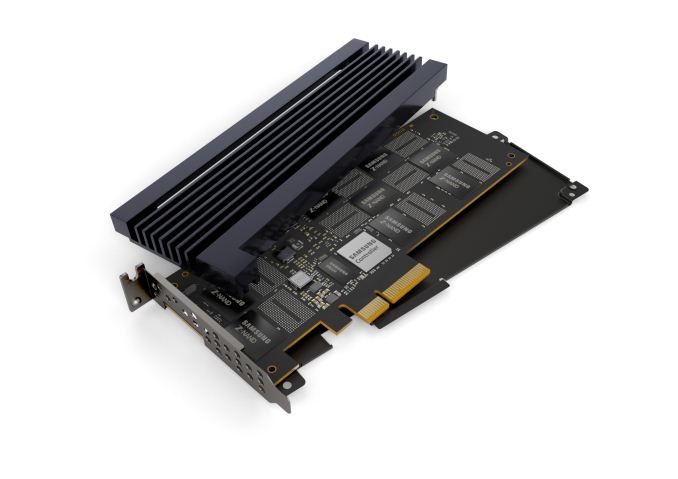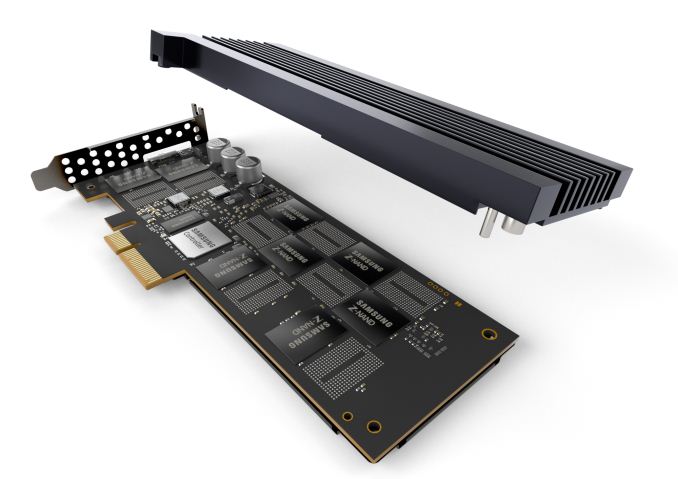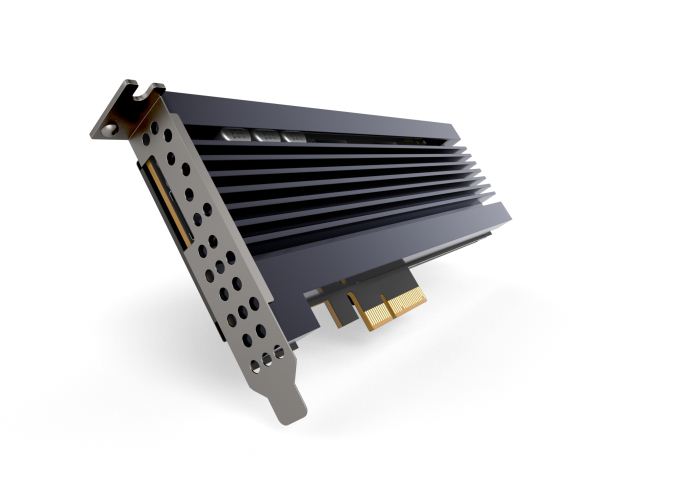Samsung Launches Z-SSD SZ985: Up To 800GB Of Z-NAND
by Billy Tallis on January 29, 2018 9:00 PM EST
Samsung announced today that they are officially launching their first Z-SSD product, the SZ985. The Z-SSD uses Samsung's Z-NAND memory, a high-performance derivative of their 3D NAND flash memory and Samsung's intended competition for Intel's 3D XPoint memory. The SZ985 is a high-performance, high-endurance enterprise NVMe SSD.
Samsung has been talking about Z-NAND and the SZ985 for quite a while, including showing off prototypes at several trade shows and conferences. Their initial announcement in 2016 of Z-NAND memory and Z-SSD drives promised 1TB drives in 2016 to be followed by 2TB and 4TB drives in 2017. Today's launch of 800GB and 240GB models is far behind that initial timeline, but the Z-SSD is finally ready for broad release, almost a year after Intel's Optane products first hit the shelves. Samsung hasn't provided much new information about how the Z-SSD works under the hood, but they have disclosed that the drive includes 1.5GB of LPDDR4 DRAM. This suggests that the Z-SSD either has huge overprovisioning with as much as 1.5TB or Z-NAND memory for the 800GB model, or that the Z-NAND is being managed in a way that requires more than the usual 1GB of DRAM per TB of NAND flash used by most SSDs.
Samsung has not provided full performance specifications for the SZ985, but they have highlighted several key metrics that put the Z-SSD in the top performance tier. The SZ985 can deliver up to 750k random read IOPS, well above the 550k IOPS that Intel's Optane SSD DC P4800X is rated for. Write performance from the SZ985 is much less impressive at only 170k random write IOPS. The random write speed rating on Intel's P4800X is only 9% slower than the random read speed, while the Samsung SZ985 will have a random write speed that is 77% slower than random reads. Samsung has not been able to overcome all of the limitations of flash memory, but they have produced some impressive improvements.
Samsung also makes a few comparisons against more mainstream enterprise SSDs based on 3D TLC NAND flash memory. The memory cell read performance of their Z-NAND is ten times higher than their 3D TLC NAND, leading to 70% higher random read throughput than their PM963 NVMe SSD. Exact read latency isn't specified, but write latency on the SZ985 is quoted as 16 µs.
Despite not having record-setting write performance, the SZ985 is still designed to handle very write-intensive workloads. The endurance rating is 30 drive writes per day for five years, matching Intel's Optane SSD. However, both drives still fall short of the long-gone Micron P320h SLC NAND SSD, in both performance and endurance (though Intel has at least exceeded the random write speed of the P320h). Samsung's most significant accomplishment with the Z-SSS SZ985 is likely that they can offer the performance of planar SLC at much lower cost thanks to their 3D NAND structure.
Samsung will be presenting the Z-SSD SZ985 at the International Solid-State Circuits Conference, February 11-15.
At Flash Memory Summit last year, Samsung announced a second generation of Z-NAND memory. The SZ985 is still a first-generation product, and drives with the second-generation Z-NAND could still be a long way from launching.
Source: Samsung












45 Comments
View All Comments
Billy Tallis - Tuesday, January 30, 2018 - link
It's really difficult. TechInsights/Chipworks does teardowns and reverse engineering where they'll decap the chips and probe them while the drive is running to see how it programs cells, and then dig into the construction of the chip with an electron microscope. They often release a few headline details of their findings as enticement to buy their extremely expensive full reports.edzieba - Tuesday, January 30, 2018 - link
"However, both drives still fall short of the long-gone Micron P320h SLC NAND SSD, in both performance and endurance (though Intel has at least exceeded the random write speed of the P320h)."The usual suspect who will come here and bitch about "Intel Optane" not crediting Micron, or 3D Xpoint being a scam to suppress SLC or similar nonsense will likely latch onto this, so pre-emptively: that 350GB Micron drive launched at $4000, or ~$4250 today. A 280GB Optane 900p goes for $390. That ~10x price increase is why nobody makes SLC NAND drives any more.
iter - Tuesday, January 30, 2018 - link
That's a rather silly way to look at it:1 - SSD prices have dropped about 5 fold since 2012
2 - the micron drive is an enterprise product, and those come at a premium, anywhere from 2x to 5x more expensive than consumer products
3 - the 375 gb enterprise version of optane costs the whooping 1500$, given the nand flash pricing trends, it would have cost 7500$ in 2012
4 - if an slc drive from 2012 beats an optane drive from 2017, it is a pretty safe bet that had someone bothered to make an slc drive in 2017, it would definitely wipe the floor with optane
5 - density wise, given that there was a 2 tb mlc product in m2 form factor in 2017, half the density of slc would make a terabyte drive possible using slc, whereas intel will not be able to launch anything over 256 gb in that form factor any time soon, so that would give slc at least 4x density advantage.
So yes, slc from 5 years ago is vastly superior to optane, which is only able to match it in one single metric. It is pretty obvious that a modern slc drive will massacre optane. And it wouldn't cost more either, it will likely be cheaper than optane due to its significant density advantage.
CajunArson - Tuesday, January 30, 2018 - link
Oh look, DDRiver has a sockpuppet account.Fun test to run to show how "crappy" Xpoint is: Turn off the 1.5GB RAM cache that Samsung had to put onto these drives to get at least paper performance levels that are near Optane drives that don't include a single kilobyte of RAM cache. Then see how "insanely superior" ordinary NAND is compared to Xpoint in a real head to head comparison instead of relying on large pools of high-speed RAM that Intel has even gone out of its way to say is faster than Xpoint.
Anything else is just stupid uninformed drivel from technically ignorant fanboy who sees "Intel" and has to hurl lies that are easily disproven by facts.
iter - Tuesday, January 30, 2018 - link
How does this address the fact that even the article acknowledges the FACT that a 5 year old slc drive is better? Oh that's right, intel fanboys do not concern themselves with facts.Lolimaster - Tuesday, January 30, 2018 - link
Don't really thing so. SLC pretty much hit their top performance by innate properties of the technology. MLC is way more crappy but modern techniques/algorithms made them look somewhat "ok". Just check when many sites were complaining years ago the moment MLC drives drives arrived with shitty 2k-4k cycles on 30-60GB MLC SSD's.iter - Tuesday, January 30, 2018 - link
Nonsense, back when consumer slc was a thing, controllers weren't anywhere near to pushing the process to its peak performance. In reality it is the controllers that contribute to pretty much ALL of the performance increase in ssd drives, the actual memory medium has only gotten worse as it shrunk down, it improves density at the expense of every performance metric.edzieba - Wednesday, January 31, 2018 - link
"it is a pretty safe bet that had someone bothered to make an slc drive in 2017, it would definitely wipe the floor with optane"Then why is every NAND manufacturer on the planet apparently dumber than a random comment-section ranter, and failing to produce any SLC whatsoever? Surely if - as you claim - it is sooooo superior to everything else, and soooo easy to make, and costs a mere 3x/4x the cost of other NAND, then they would be raking in the cash of high performance high endurance premium drives? Intel/Micron are not the only NAND manufacturers after all, so even if the "artificially pump 3D XPoint" conspiracy is somehow correct, it doesn't explain how everyone else is refraining from eating their lunch with cheaper, better parts.
Or, just maybe, the people who make these parts know that it's not as simple as "half capacity double cost double performance!".
peevee - Tuesday, January 30, 2018 - link
You compare 2012 prices to 2018 prices?SLC NAND chips are precisely 2 times more expensive than MLC and 3 times more than TLC.
iter - Tuesday, January 30, 2018 - link
Intel and micron were extremely lucky that the industry walked away from slc. Had this not happened, their years long and costly investment in xpoint would be diminished significantly. Thanks to the absence of slc drives, they can hide the fact that xpoint was pretty much a waste, considering the fact they could have gotten better performance out of good old slc and save a lot of time and money on developing a redundant technology.Granted, xpoint improves on the few weaknesses of flash nand, but even so, the improvements are not really worth the investment. The reason the industry walked away from slc was that it was too good, even for the enterprise, they could get more than enough performance from denser and more profitable nand varieties.
For a consumer usage scenario, even the difference between a sata and a nvme drive is negligible, and for most of the prosumers too. So even more performance is entirely redundant, and intel only went for it because it had to present something to show for their investment.
It is quite clear that optane is not selling out even in the enterprise, where it actually makes some sense in a few niche workload scenarios. Because if it did sell out, intel wouldn't be marketing it 3 times cheaper on ... friggin gamers, who have exactly zero use of it. It goes without saying, it is not some unprecedented, newly found love for consumers that is forcing intel to sell xpoint at a much lower profit target, they literally don't have anything better to do with it.
Which also explains why znand is in really mediocre mlc + improved controller + marketing nonsense. There is no need for something as fast as slc, and samsung are simply following intel's example, as quite obviously, a little hype can get a long way.